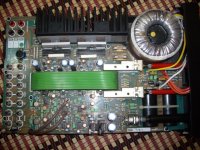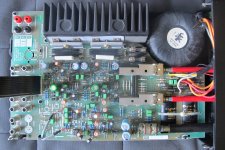Hi hacknet,
Do you plan on doing more of this work?
What equipment do you have?
I can't help avoid bad things happening if you don't have some of the basic things to service properly. So you have to ask yourself if you should get some service gear, or send the amp for service. There is a reason the better servie techs are worth their weight in gold. And some of them are pretty heavy! 😉
-Chris
Do you plan on doing more of this work?
What equipment do you have?
I can't help avoid bad things happening if you don't have some of the basic things to service properly. So you have to ask yourself if you should get some service gear, or send the amp for service. There is a reason the better servie techs are worth their weight in gold. And some of them are pretty heavy! 😉
-Chris
As well as replacing the drivers, it would be worth checking the base and emitter resistors of the drivers and output devices. The Cyrus 2 I repaired took out one of these.
Don't mess about putting in cheap outputs then getting it working then swapping them for better ones as you will only ruin the PCB, just power it safely in the first place. Use 100 ohm resistors instead of the fuses if you can't get use of a proper bench supply.
Don't mess about putting in cheap outputs then getting it working then swapping them for better ones as you will only ruin the PCB, just power it safely in the first place. Use 100 ohm resistors instead of the fuses if you can't get use of a proper bench supply.
thanks for the advice man!
i have a good feeling that i have actually busted the emmiter resistors too!
i'll check and report back!
i have a good feeling that i have actually busted the emmiter resistors too!
i'll check and report back!
I'm impressed.i have a good feeling that i have actually busted the emmiter resistors too!
Doing a job right normally is inconvenient. 😉
-Chris
the op devices are gone, 1 channel's drivers are dead, the predrivers are fine. the vbe multipler are alright.🙂
I was talking about resistors...
I'd replace both channels drivers as a matter of routine as well. I've known them measure OK on diode check but go cranky not long after using again.
I'd replace both channels drivers as a matter of routine as well. I've known them measure OK on diode check but go cranky not long after using again.
the resistors are just perfect!
i got dodgy 3055s once and they gave way almost immediatly although the meter said they were perfect... after checking everything, a new pair of ST ones did the trick.
i got dodgy 3055s once and they gave way almost immediatly although the meter said they were perfect... after checking everything, a new pair of ST ones did the trick.
Input Cinch Sockets and Alps Input Selector Switch - where to order
For several user's I need new input selector swtiches, potentiometer and input sockets (also suited for Cyrus II resp. Cyrus TWO).
From where I can order this parts?
An other possibility it would be, to resolder such a switch and potentiometer from a used amp/receiver part from far-east (e. g. Kenwood).
Who know, in which of such models the same swtich type is in use?
And what is the right name in colloquial English for this kind of switch (I don't think "Rotary switch") ??
Thanks for advices.
For several user's I need new input selector swtiches, potentiometer and input sockets (also suited for Cyrus II resp. Cyrus TWO).
From where I can order this parts?
An other possibility it would be, to resolder such a switch and potentiometer from a used amp/receiver part from far-east (e. g. Kenwood).
Who know, in which of such models the same swtich type is in use?
And what is the right name in colloquial English for this kind of switch (I don't think "Rotary switch") ??
Thanks for advices.
Attachments
Last edited:
No informations?
From Alps I have heard, that this input selector switch wasn't custom made version for Mission.
This means, that this switch is in use by several models of japanese brands (maybe Pioneer, Kenwood etc.).
Perhaps one of the members know the appropriate models.
From Alps I have heard, that this input selector switch wasn't custom made version for Mission.
This means, that this switch is in use by several models of japanese brands (maybe Pioneer, Kenwood etc.).
Perhaps one of the members know the appropriate models.
Last edited:
I have got a Cyrus Two version 6 which has blown PT7 transistors. BUV28 is not available from RS or Farnell. Some has suggested MJE3055T as a replacement. Only two PT7 are blown.
Is it alright to replace two PT7 with MJE3055T? Do I need to replace all eight PT7 transistors?
Mission Cyrus 1 problems - UK Vintage Radio Repair and Restoration Discussion Forum
Is it alright to replace two PT7 with MJE3055T? Do I need to replace all eight PT7 transistors?
Mission Cyrus 1 problems - UK Vintage Radio Repair and Restoration Discussion Forum
MJE3055T is not really suitable as it would be running too close to its voltage rating. It is also low gain and slow.
The following are available from Farnell
PHE13009
ST13009
BUL89
If the two that are blown are both in the upper or lower half of one channel only, then you can replace just those. If there is one here and one there then you need to replace the whole lot.
The following are available from Farnell
PHE13009
ST13009
BUL89
If the two that are blown are both in the upper or lower half of one channel only, then you can replace just those. If there is one here and one there then you need to replace the whole lot.
Last edited:
Did early C2 come with eight PT7? 😕
Thought C1 had PT7 and C2 PT77, both just four of them total, two per channel.
Thought C1 had PT7 and C2 PT77, both just four of them total, two per channel.
Today I have get a humming Cyrus ONE (all caps was already replaced by Panasonic versions) due an interrupted 15R resistor "R121" between GND and chassis (go to the attachment - first three images).
The usual present parallel connected capacitor was not in use.
Sometimes by a high current flow blown this resistor.
What is the main reason therefore ?
Additional I note a bypass-cap on only one of the both 10mF/63V behind the rectifier (the cap between pos. rail and GND - go to the fourth image).
is there a special reason for that ?
The used output power devices for this quasi complementary output buffer stage are different for L+R - go to the images No 5-8. Which exact type from SGS-Thomson is behind the PT-7 ?
The fast recovery diodes for rectifier PFR852 (last image) - go to
PFR852 pdf, PFR852 description, PFR852 datasheets, PFR852 view ::: ALLDATASHEET :::
are genuine equipped with or not ?
Thank you for your information.
Sonic quality of this amp device is excellent in all respects.
The usual present parallel connected capacitor was not in use.
Sometimes by a high current flow blown this resistor.
What is the main reason therefore ?
Additional I note a bypass-cap on only one of the both 10mF/63V behind the rectifier (the cap between pos. rail and GND - go to the fourth image).
is there a special reason for that ?
The used output power devices for this quasi complementary output buffer stage are different for L+R - go to the images No 5-8. Which exact type from SGS-Thomson is behind the PT-7 ?
The fast recovery diodes for rectifier PFR852 (last image) - go to
PFR852 pdf, PFR852 description, PFR852 datasheets, PFR852 view ::: ALLDATASHEET :::
are genuine equipped with or not ?
Thank you for your information.
Sonic quality of this amp device is excellent in all respects.
Attachments
-
 DSCF6909.jpg982.2 KB · Views: 245
DSCF6909.jpg982.2 KB · Views: 245 -
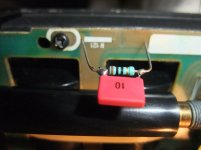 DSCF6919.jpg979.9 KB · Views: 237
DSCF6919.jpg979.9 KB · Views: 237 -
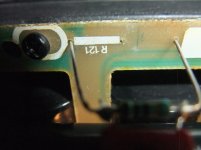 DSCF6921.jpg979.5 KB · Views: 236
DSCF6921.jpg979.5 KB · Views: 236 -
 DSCF6911.jpg996.2 KB · Views: 250
DSCF6911.jpg996.2 KB · Views: 250 -
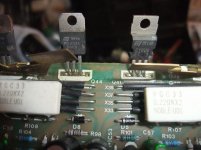 DSCF6903.jpg990.9 KB · Views: 235
DSCF6903.jpg990.9 KB · Views: 235 -
 DSCF6904.jpg1,018.3 KB · Views: 201
DSCF6904.jpg1,018.3 KB · Views: 201 -
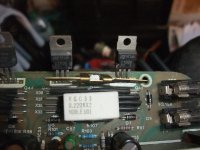 DSCF6905.jpg989.1 KB · Views: 199
DSCF6905.jpg989.1 KB · Views: 199 -
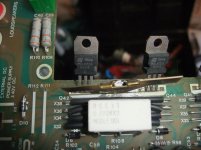 DSCF6907.jpg989.7 KB · Views: 224
DSCF6907.jpg989.7 KB · Views: 224 -
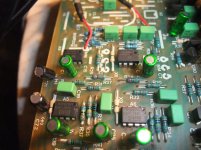 DSCF6915.jpg995.7 KB · Views: 180
DSCF6915.jpg995.7 KB · Views: 180 -
 DSCF6913.jpg982.4 KB · Views: 188
DSCF6913.jpg982.4 KB · Views: 188
Last edited:
The PT7 are supposed to be BUV28/BUV28A fast switching devices.
If you fit standard audio transistors the amp tends to sound dull and lifeless to me. I had a cyrus one with PT7 in one channel, and some generic linear parts in the other, the linear parts sounded rubbish. I have found parts like FJP13009 work better as replacements.
If you fit standard audio transistors the amp tends to sound dull and lifeless to me. I had a cyrus one with PT7 in one channel, and some generic linear parts in the other, the linear parts sounded rubbish. I have found parts like FJP13009 work better as replacements.
Thank you.
According datasheet the BUV28 is suited for SMPS e. g. (fast switching character) but actually not suited for linear applications - go to
https://www.st.com/resource/en/datasheet/buv28.pdf
The main feature in the datasheet is the absence of a SOA diagram.
So the question arises, what about the reliability of the power amp units.
According datasheet the BUV28 is suited for SMPS e. g. (fast switching character) but actually not suited for linear applications - go to
https://www.st.com/resource/en/datasheet/buv28.pdf
The main feature in the datasheet is the absence of a SOA diagram.
So the question arises, what about the reliability of the power amp units.
Last edited:
The Misson Cyrus amplifier designs 1,2 both used switching power transistors in quasi-complementary arrangement, as did other UK brands of the era, such as early Naim models, before the advent of Japanese developed, multi-emitter transistors which were both fast and more linear. Cyrus 3 used intermediate audio power transistors 2SD1047/B817 as per Rotel.
The speed of switching was always considered important for reducing crossover distortion, which many would say is worse than asymmetric, such as quasi complementary output stages which tend to generate even rather than odd harmonic distortion. Often, that type of distortion sounds pleasing to listeners but crossover distortion is never good.
The speed of switching was always considered important for reducing crossover distortion, which many would say is worse than asymmetric, such as quasi complementary output stages which tend to generate even rather than odd harmonic distortion. Often, that type of distortion sounds pleasing to listeners but crossover distortion is never good.
Last edited:
- Home
- Amplifiers
- Solid State
- Cyrus One
